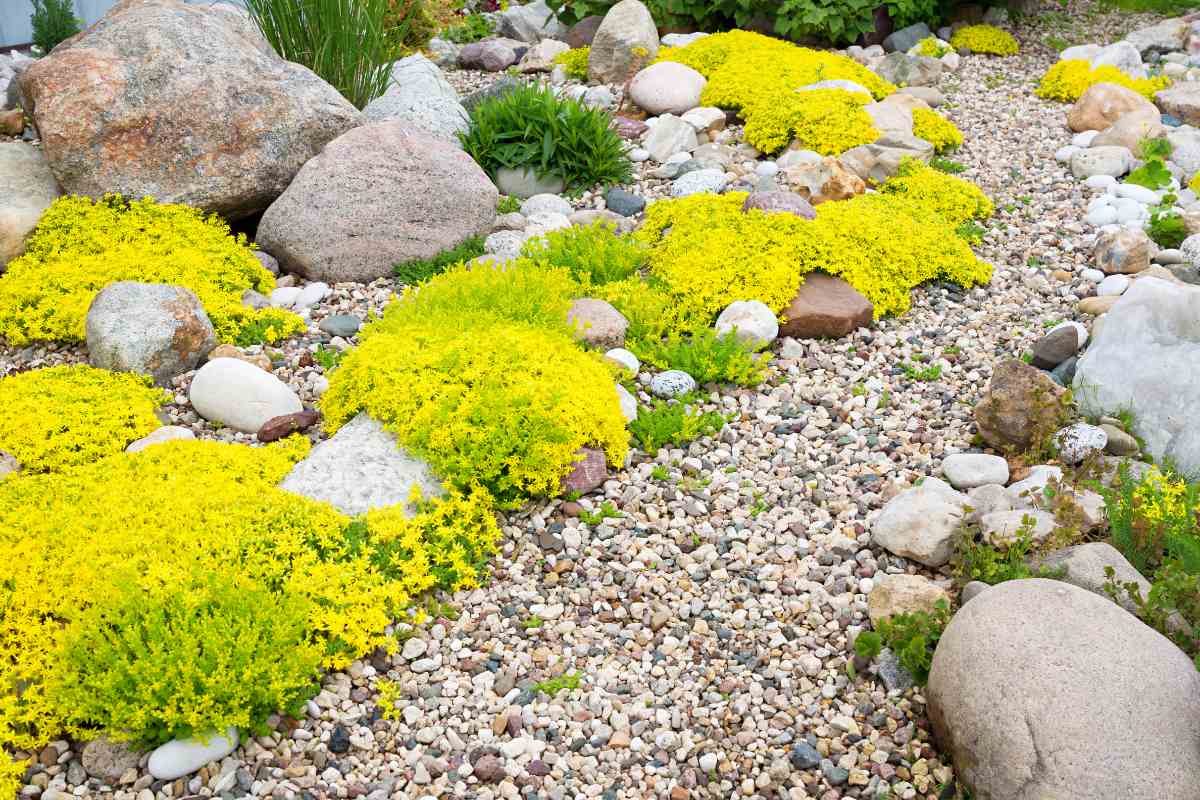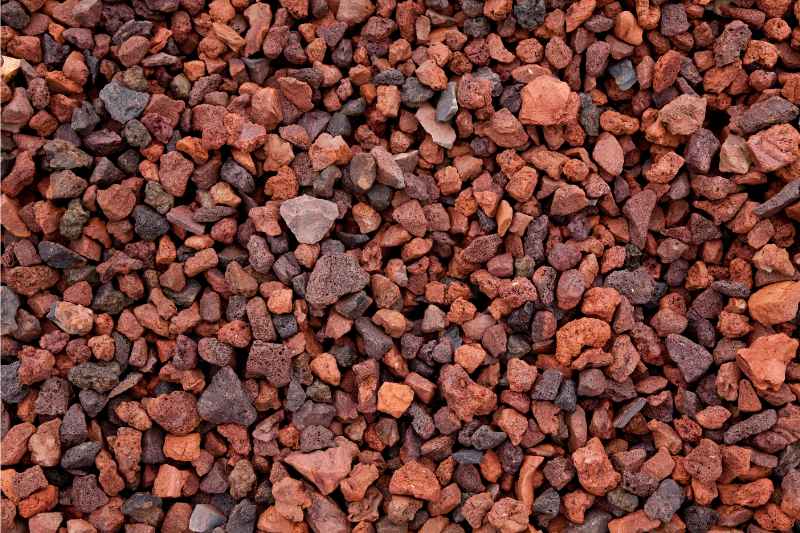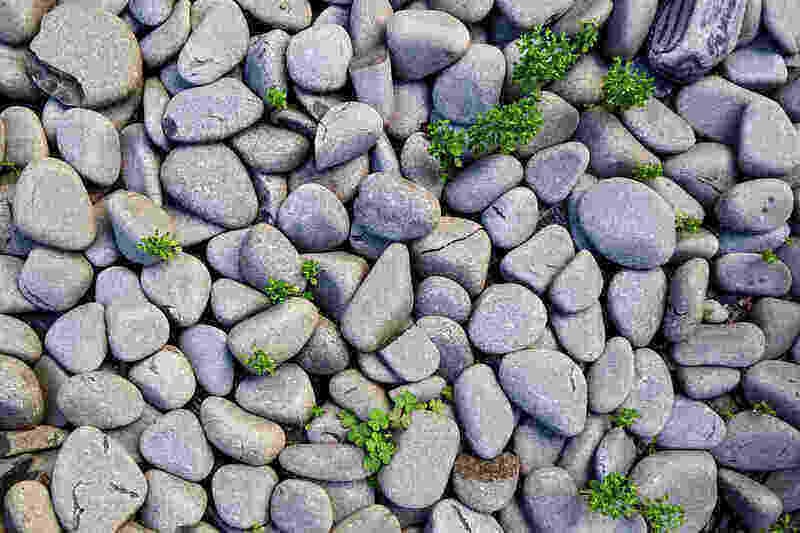
The best landscaping rocks for your yard project will vary depending on your outdoor space needs, curb appeal goals, and your landscaping ideas. But why are millions of homeowners choosing to use rocks in their landscaping?
Not all beauty is found in greenery. Landscaping rocks are formed and polished, and using them for your yard project could cut down on maintenance and conserve water. The question is, what are the best rocks for your landscaping project?
Let’s break up the rocks into which ones are best for your landscape:
Best Landscaping Rocks for Your Yard Project
There are many types of landscaping rocks for your yard project that can increase the value, functionality, and uniqueness of your property. Think of a brick sidewalk to your front door or shiny pebbles for your Zen garden. Landscaping rocks can also be functional, such as flagstone stairs leading to your hot tub or garden.
Bricks, river rocks, and flagstone are excellent for accenting flower beds. They’ll also work to create a path to a gazebo or serve as a wall around your garden. All these materials are only a stone’s-throw away.
Pea Gravel

Pea gravel refers to small, rounded stones about the size of the green vegetable they’re named after, and they’re already polished, thanks to Mother Nature.
Best Ways to Use: If you’re looking to incorporate rocks into your backyard landscaping, consider pea gravel. It adds a textural design component and can be used in patios, playgrounds, and firepits. It’s also ideal for framing and filling in spaces between larger landscaping stones: Flagstone stepping stones surrounded by pea gravel give you a functional yet textural design.
For yards with xeriscaping, pea gravel is a perfect rock for flower beds, helping to control weeds and cover the soil around your cacti and succulents. Not only can you skip the mulch, but you’ll also save on your water bill.
Pros:
- Cost-effective and versatile
- Doubles as weed control and increases drainage
- Can be an alternative to mulch
Cons:
- You can’t comfortably take a barefoot stroll on your pea gravel landscaping
- With heavy rain, it can wash away
Cost: Pea gravel costs $46 a cubic yard on average. If you want colored pea gravel, prepare to budget for an extra $20-50 per cubic yard.
Lava Rock

Lava rock is a popular choice among homeowners. The rough, misshapen, red rocks are a bit more expensive than pea gravel but an excellent long-term investment.
Best Ways to Use: Lava rock can be used to replace mulch in flower beds or to add color to the border of a walkway. It could be a top contender in the best rocks for landscaping category due to its durability, long lifespan, and different colors like black, red, and gray.
Pros:
- Doesn’t wash away
- Retains moisture; keeps weeds and pests away; and has a long lifespan
Cons:
- Absorbs heat and reflects light, which will increase the temperature around your plants
- Difficult to clean; hard to move if you change your mind; sinks into the soil
Cost: Lava rocks cost around $20 for a 10-lb bag.
River Rock

Polished, rounded, and smoothed by running water, river rocks can be found near freshwater sources. Typically they are 1 to 2 inches in diameter, but can be as large as 6 inches in diameter and come in a variety of colors and shapes.
Best Ways to Use: Like pea gravel, river rocks are versatile and popular rocks for garden bed edging, in xeriscaping beds, and atop potted succulents. River rocks are also used for low-activity patios, accents, and flowerbeds.
Pros:
- Excellent drainage and erosion control.
- Versatile and unique. Being small, they fit almost anywhere. Due to the wide variation in size, color, and shape, no two river rock pieces are alike.
Cons:
- Adding plants to existing beds is challenging.
- Like lava rocks, they can retain heat and be difficult to clean and move.
Cost: River rocks can be a bit pricey, costing around $15 per 5 pounds. But they’re a versatile landscaping rock for your yard projects.
Flagstone

Flagstone is broken-up sedimentary rock. This natural stone has several types, including sandstone, quartzite, bluestone, and limestone. They come in two shapes: cut and irregular.
Best Ways to Use: Flagstone is a popular option for hardscaping patios, walkways, and stepping stones while also being a beautiful choice for dry-laid garden walls.
Pros:
- Durable and doesn’t shift in different climates, including Arizona’s very hot and Alaska’s very cold weather
- Low maintenance. Just give it a sweep or a spray to clean.
Cons:
- Can be pricey and is labor-intensive to install.
- The surface will get very hot with high temperatures and slippery with rain.
Cost: Flagstone has several subtypes, so the price may vary depending on whether you’re getting slate, limestone, or sandstone. Visit a local stone yard to find the most affordable options in your area.
Cobblestone

Cobblestones are essentially large river rocks. They can be found in river beds and have been smoothed down by moving water. They come in different sizes, shapes, and colors. They’ve been used as paving and landscaping material since the 3rd century.
Best Ways to Use: Cobblestone is used for patios, garden borders, and water features. Homeowners can also spruce up their front yard by using it to accent their driveways — to edge the driveway and make a rumble strip at the driveway entrance.
Pros:
- Extremely durable. They’ve been used in paving walkways and streets since the 3rd century. You’ll likely never need to replace them.
- Unique, easy to clean, stain, and weather resistant.
Cons:
- They are costly. Weigh the benefits with the cost to see if it’s right for you.
- An uneven surface can be challenging for snow removal and unsteady legs (toddlers, the elderly, and people with two left feet – like me).
Cost: Cobblestone is quite pricey, ranging from $690 to $915 per 100 square feet.
Brick

Traditionally fired clay, contemporary brick now comes in all sorts of materials.
Best Ways to Use: Brick can add a touch of sophistication to your property if you prefer a more traditional, historic touch. It can be used for walkways, patios, driveway pavers, and garden walls.
Opting for a linear brick design can be a more economical choice when compared to a circular design, as it requires less cutting on-site.
Pros:
- Durable
- Easy to maintain, easy to wash
Cons
- Due to their shape, making unique designs can be challenging
- Inflexible: changing, replacing, or removing bricks is not easy
Cost: The price of brick varies with the materials but ranges from $6 to $10.50 per square foot.
Red Tipple
Red tipple is a beautiful natural stone with a reddish hue that is available in several sizes, most commonly 3/8 inch and 3/4 inch. The two sizes can be used in different applications, and they are both usually sold by the ton. If you require a smaller amount, you can also purchase it in bags.
Best Ways to Use: The smaller 3/8 inch works better for gravel driveways or natural walkways. This size could also be used as a replacement for mulch. It’s recommended to use a weed block fabric beneath it for a gravel driveway.
The larger 3/4 inch red stone can be used as a replacement for mulch. For best results, use weed block fabric underneath it.
Pros:
- Low maintenance compared to mulch (It doesn’t decompose or wear out)
- Long-term weed control when used with weed control fabric
- Beautiful decorative reddish color that will complement your landscaping
- Smaller stones are easier to work with
Cons
- Red tipple won’t enrich your plants and soil like mulch.
- The stones can become a projectile hazard if they get caught in the lawn mower.
- It’s challenging to remove it from your landscaping once it’s installed.
Cost: The price of red tipple stone can vary depending on the size. The 3/4 inch stone is available at around $64 per ton. The 3/8 inch is available for $98 per ton. The price will also vary if you want it delivered and installed.
Decomposed Granite

Photo Credit: Pistils Landscape Design + Build / Flickr / CC BY-SA 2.0
Decomposed granite, also called DG, is a type of granite rock that has undergone weathering to the extent that the original material easily breaks down into smaller and weaker rock pieces. It’s available in various sizes and colors and is a cost-effective option.
Best Ways to Use:
Decomposed granite is a versatile material that can be used in various landscape projects. It’s a popular choice for patios, garden pathways, parks, driveways, and other areas that experience high foot traffic. If mixed with a soil stabilizer, it can last for years and provide a sturdy surface.
Pros:
- Once compacted properly, DG offers a stable and even surface.
- DG can handle water run-off efficiently and is very permeable.
- Available in a diverse range of natural colors, it can add to the rustic charm of landscapes.
Cons
- DG can stick to your shoes.
- Don’t use DG near your home’s exterior doors, or use a doormat at each of your doors to prevent ruining your floors.
- DG will need to be recompacted and redressed periodically since it’s not a completely maintenance-free option like concrete.
Cost: The 3/8 inch decomposed granite is available in red, blue, or gray and runs about $60 per ton (or 0.74 cubic yards). However, if you opt for the stabilized version of decomposed granite, it will cost you $185 per ton (or 0.74 cubic yards) due to its increased durability and long-lasting nature.
Note: Since decomposed granite has no stabilizers (no binders or additives), it’s more susceptible to erosion from wind and storm run-off or mechanical damage (such as snow plows in the winter).
Even though DG costs 50% less than stabilized DG, you’ll be spending more money in the long run to replace the eroded sections of your landscape.
Crushed Stone

Crushed stone and decomposed granite (DG) are both types of aggregates used in landscaping. However, crushed stone is not as finely crushed as DG.
Best Ways to Use: Crushed stone can be used as a replacement for mulch for your garden beds. It can also be used as a stone driveway for a more natural look.
Pros:
- Crushed stone has great versatility in your landscape design ideas, with the caveat that it must be installed correctly. It must be poured and compacted properly.
- It’s easier to install than other materials like concrete because you just dump it out of the dump truck, smooth it, and then tamp it down.
Cons
- It’s probably not the best choice for play areas because it does have rough edges.
- Crushed stone will need replenishing every few years as it tends to scatter.
Cost: Crushed stone prices are as follows: $10 to $50 per ton, $15 to $75 per yard, and $1 to $3 per square foot. Prices will vary depending on if you want the crushed stone delivered and/or installed.
Boulders

Boulders are a striking and versatile choice for landscaping projects, offering a natural aesthetic that can complement a variety of yard styles. These large rocks can serve as focal points in a garden, create natural-looking boundaries, or even function as seating elements.
Best Ways to Use: Boulders have many design applications. They can be used singly or in groups. They are used in groups for natural, sturdy retaining walls. You can also edge your garden beds with them to keep the soil in place. Some homeowners like to use them as steps.
Boulders can serve as an accent feature in a garden bed or as focal points in a water feature when used alone. Homeowners often prefer to use large boulders and position them at the end of their driveway, displaying their house number on them.
Pros:
- Boulders are durable, adaptable, and can last many years.
- They don’t require any upkeep.
- Boulders are versatile as landscape rocks for various applications.
- Boulders have environmental benefits such as erosion control.
- You can also level out your yard with boulders if there’s a steep slope by making a natural retaining wall.
Cons
- Boulders can be extremely expensive, depending on the size.
- Boulders can be very heavy also, depending upon the size.
- You might need the pros to come in and help with the delivery and placement of the boulder. Once it’s in place, the heavier the boulder, the less likely you’ll be able to move it without heavy machinery.
Cost: The cost of boulders can vary based on their size and type, with an average price range of $100 to $600 per ton. Many stone yards sell directly to homeowners, and the prices usually depend on the quantity and quality of the stones.
Note: If you want the boulder delivered and installed, you might need to call upon the pros. Boulders can weigh hundreds of pounds or more. The price can vary based on the boulder size, the type of stone, where you live, and where you want it placed. They might need to bring in a backhoe or other equipment.
How to Use Rocks in Your Landscape
Spread Rocks as Ground Cover

A rock garden can save you a brickload of money on landscaping. Why? It’s a bed of rocks, often featuring shrubs or cactus. There’s no lawn to mow, fertilize, or water, and the porous rock allows rain to soak into the ground.
Landscaping rocks also can help prevent erosion and run-off.
Several varieties will work for a rock garden, but these rocks work best for ground cover:
- Pea Gravel
- Lava Rocks
- River Rocks
For additional ideas on using rocks as ground cover, explore these xeriscaping ideas to help bring your low-water, low-maintenance vision to fruition.
Lay Rocks as Pavers

If you’re using landscaping rocks for your paving project, you may want a smoother texture. Depending on the aesthetic you’re going for, you may want to use larger rocks for your driveway, walkway, or patio:
- Brick
- Flagstone
- Cobblestone
Use Rocks to Build a Garden Bed

Thinking about raised garden beds or a retaining wall? Landscaping rocks can help. The rocks can give your yard a lift and create layers of beauty around the property.
You can use just about any sort of landscaping rock to build retaining walls or raised beds, but keep these two things in mind:
- Organization: Group your landscaping rocks into large, medium, and small. You’ll build the walls of your garden bed with the large landscaping rocks at the bottom and use the smaller ones as filler and support. Depending on your design, there are different techniques for building sturdy garden bed walls.
- Drainage: Contrary to popular belief, using stones at the bottom of your raised garden won’t help with drainage. In fact, it can impede drainage by creating a water table. The better alternative is to use a soil mix that has a high organic matter content.
Note: A word about pests — If you’re worried about pests, such as moles, infiltrating the base of your raised garden beds, you can lay down hardware cloth before filling them with soil. This method can help keep the pests at bay while still allowing water to drain out.
FAQ About Landscaping with Rocks
How Can I Use Landscaping Rocks in Creative Ways?
When it comes to landscape design with rocks, you can let your imagination run wild. Build natural ponds or streams through the yard, create a retaining wall with plants, or accent a koi pond.
Whether building a waterfall, decorating a pond, or constructing a themed garden, it’s best to mix up rock types. Include some boulders, use flagstone to create the base and limestone for a porous effect, and create an interesting water flow. Look for examples at home and garden shows (and, of course, here on LawnStarter’s landscaping pages).
Do You Need to Put Anything Under Landscaping Rocks?
Yes, you’d want to do it primarily for stabilization. Areas that would benefit from materials under landscaping rocks are walkways, patios, and areas where you don’t want the stones to sink down.
Pro Tip: The pros typically use permeable landscape fabric, crushed stone, decomposed granite, and/or sand as a stabilizing base.
Although you have a few options, the most common and versatile is landscaping fabric. Landscaping fabric greatly reduces weed growth and plants poking in between rocks. It also prevents rocks from sinking into the soil — a common occurrence, especially with smaller rocks like pea gravel and lava rocks.
There are several types of landscaping fabric to choose from:
• Woven
• Non-woven
• Spun
• Perforated
The type you choose will depend on the type of rock you choose and your landscaping goals.
Can I Get Free Landscaping Rocks?
Yes. Landscaping with rocks can get expensive, so if you’re not picky or you’re super creative, you can get free rocks from a few places.
- Construction sites: Talk to a construction crew. Chances are they have quite a few rocks that they’d be happy to hand over.
- Farms: Ask a farmer if you can help de-rock their land. Chances are they’ll readily agree to the tradeoff.
- Go rockhounding: Rockhounding is just rock collecting. Although it’s not allowed in national parks, most national forests will let you gather rocks to your heart’s content. Dry creek beds are a great place to start.
Are There Other Rocks I Can Use?
The landscaping and hardscaping options are nearly limitless. Here are a few that were left off the list and why.
- Beach pebbles: A beautiful option, but also one of the most expensive.
- Mexican beach pebbles: A popular choice for water features but very expensive.
- Marble chips: The light reflects, making them luminous, but they get very hot and damage your greenery. They also have a high pH balance and leach into the soil.
When to Call a Landscaping Pro
If you find yourself short on time or lack the skills to bring your DIY landscaping vision to life, a professional landscaper near you can show you how to turn your vision into a reality. They can assist you with landscaping projects ranging from a basic stone pathway to a large rock wall complete with a waterfall cascading into a bog garden.
LawnStarter participates in the Amazon Services LLC Associates Program, an affiliate advertising program. LawnStarter may earn revenue from products promoted in this article.
Main image credit: yanikap / Canva Pro / License





